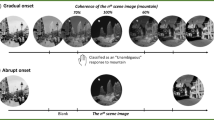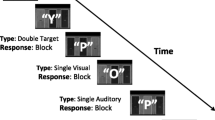Abstract
The purpose of this study was to examine the effects of workload history (specifically sudden workload shifts) on performance. A sample of 204 undergraduates was randomly assigned to either a sudden decrease or increase in workload condition. Participants simultaneously performed a memory search task (i.e., primary task) and an auditory vigilance task (i.e., distracter task), while percent correct was recorded. Separate Repeated Measures ANOVA’s revealed a significant treatment effect for the Medium to Low (F(l, 110) = 274.6, p < .01) and Low to Medium (F(l,92) = 148.3, p < .01) conditions. Results supported previous research suggesting that either a sudden decrease (Medium to Low) or increase (Low to Medium) in workload could be detrimental to performance (Cox-Fuenzalida, 2000). More importantly, this study extends the detrimental effects of workload history to a dual task environment.
Similar content being viewed by others
References
Ballard, J.C. (1996). Computerized assessment of sustained attention: A review of factors affecting vigilance performance. Journal of Clinical and Experimental Neuropsychology, 18(6), 843–863.
Bourke, P.A. (1997). Measuring attentional demand in continuous dual-task performance. The Quarterly Journal of Experimental Psychology, 50A(4), 821–840.
Cox-Fuenzalida, L.E. (2000). Effect of workload history on vigilance performance. Unpublished doctoral dissertation, University of Oklahoma, Norman.
Cox-Fuenzalida, L.E., Swickert, R.J., & Hittner, J.B. (2003). Effect of neuroticism and workload history on performance [Electronic version]. Personality and Individual Differences, 36, 447–456.
Cumming, R.W., & Croft, P.G. (1973). Human information processing under varying task demand. Ergonomics, 16, 581–586.
Davies, D.R., & Parasuraman, R. (1982). The psychology of vigilance. New York: Academic Press.
Goldberg, D.R., & Stewart, M.R. (1980). Memory overload or expectancy effect? “Hysteresis” revisited. Ergonomics, 23, 1173–1178.
Matthews, G., & Davies, D.R. (2001). Individual differences in energetic arousal and sustained attention: A dual-task study. Personality and Individual Differences, 31, 575–589.
Matthews, M.L. (1986). The influence of visual workload history on visual performance. Human Factors, 28 (6), 623–632.
Parasuraman, R., Warm, J.S., & Dember, W.N. (1987). Vigilance: Taxonomy and utility. In L.S. Mark, J.S. Warm, & R.L. Huston, Ergonomics and human factors: Recent research (pp. 11–32). New York: Springer-Verlag.
Riby, L.M, Perfect, T.J., & Stollery, B.T. (2004). The effect of age and task domain on dual task performance: a meta-analysis. European Journal of Cognitive Psychology, 16(6), 863–891.
Sternberg, S. (1966). High-speed scanning in human memory. Science, 153(3736), 652–654.
Warm, J.S., Dember, W.N., & Hancock, P.A. (1996). Vigilance and workload in automated systems. In R. Parasuraman & M. Mouloua (Eds.), Automation and human performance: Theory and applications (pp. 183–200). England: Lawrence Erlbaum Associates, Inc.
Wickens, C.D. (1984). Processing resources and attention. In R. Parasuraman, & D.R. Davies, Varieties of attention (pp. 63–102). Orlando, FL: Academic Press.
Wickens, C.D. (2002). Multiple resources and performance prediction. Theoretical Issues in Ergonomie Science, 3(2), 159–177.
Author information
Authors and Affiliations
Corresponding author
Additional information
The authors express their gratitude to the research team from the Personality and Human Performance Lab at the University of Oklahoma for their invaluable assistance in data planning and collection.
Rights and permissions
About this article
Cite this article
Cox-Fuenzalida, LE., Angie, A.D. The effects of workload history on dual task performance. Curr Psychol 24, 171–179 (2005). https://doi.org/10.1007/s12144-005-1020-y
Issue Date:
DOI: https://doi.org/10.1007/s12144-005-1020-y




